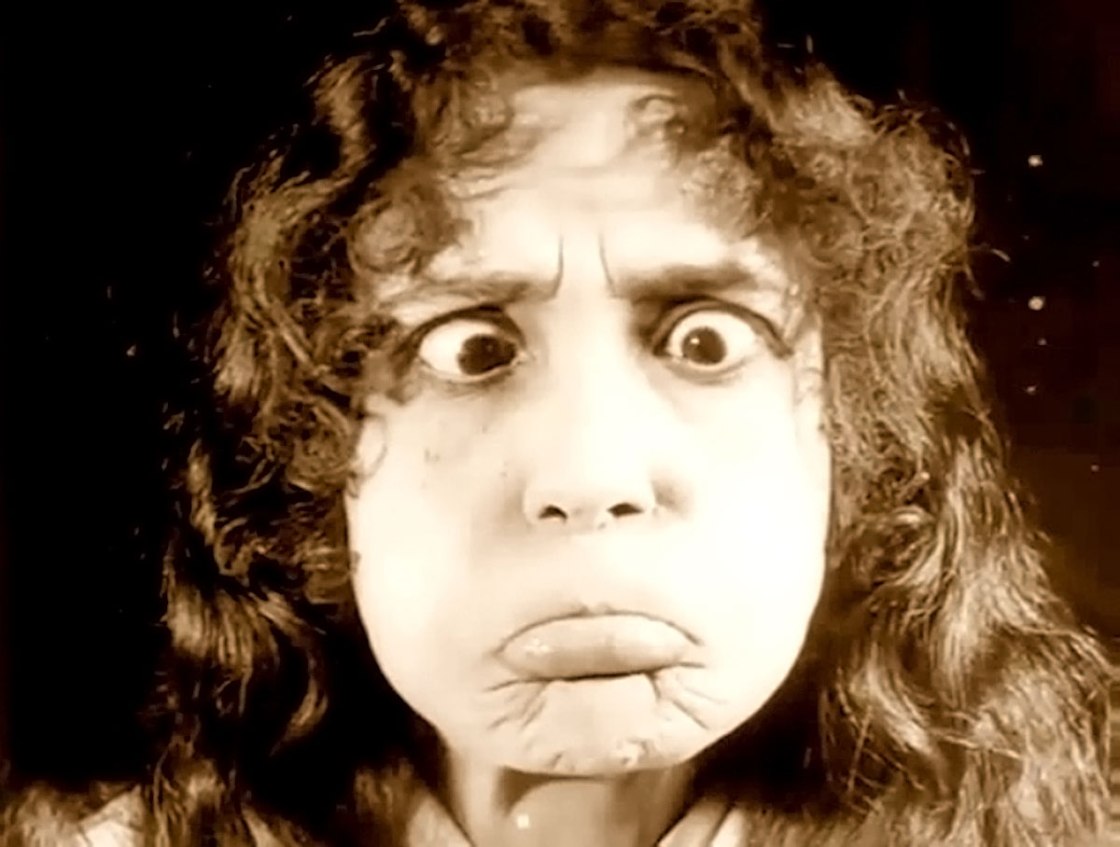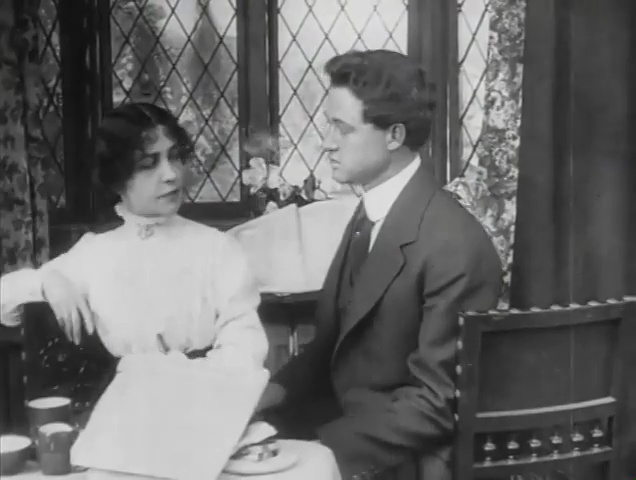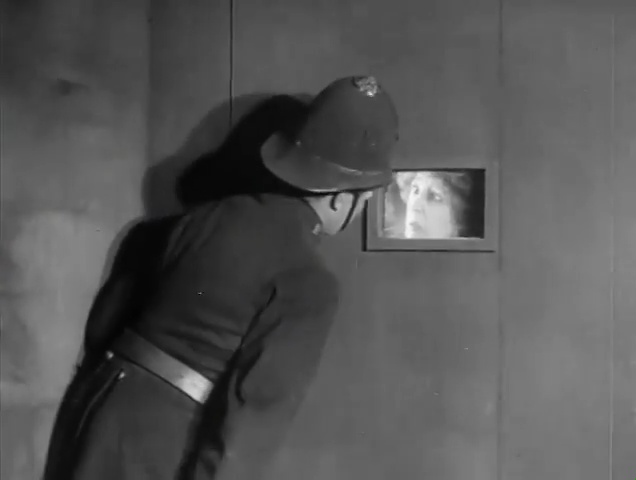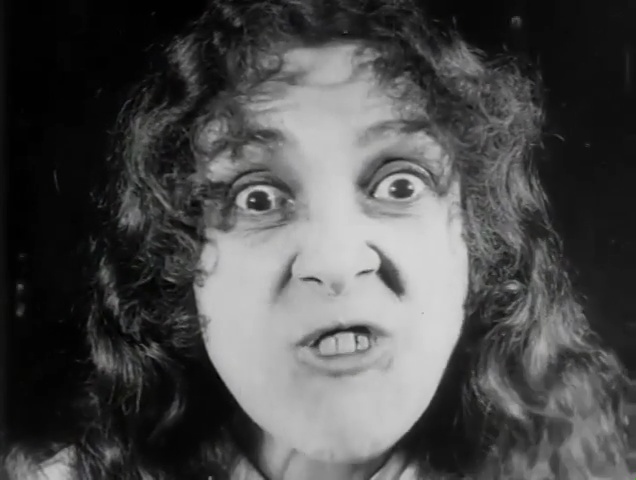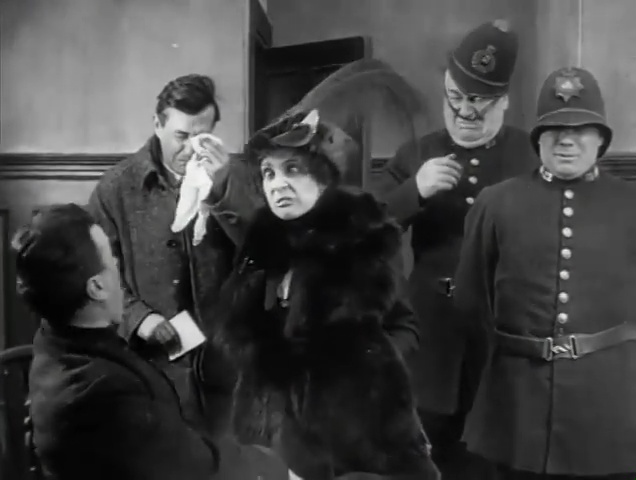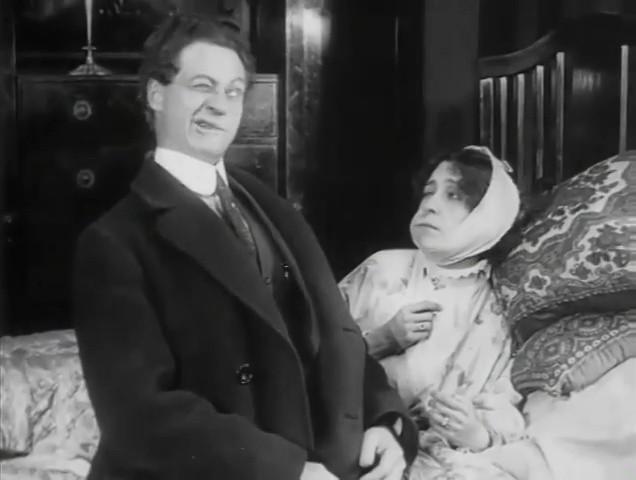A husband and wife find themselves at odds when she is forced to drop out of an amateur face-making contest and he wins the big prize. Her determination to win the next contest causes chaos and ends with police intervention. One of American star Florence Turner’s English productions.
Home Media Availability: Stream courtesy of the BFI.
Put on a happy face
As of this writing, Hollywood filmmaking is awash in handsome men named Chris. Well, in the days of the early star system, there were Florences: Lawrence, La Badie and Turner. Florence Turner was among the first big name movie stars and was a top draw at Vitagraph before she decamped to Britain and started her own production company with the help of fellow Vitagraph veteran, Laurence Trimble, an actor, director and dog trainer.
Most of Turner’s British work is lost forever and I am particularly sad about the loss of Far From the Madding Crowd. Her comedy short, Daisy Doodad’s Dial, is about as far from Thomas Hardy as you can get but it is significant because it is her only known directing credit.
It is worth noting that behind-the-camera roles were not as firmly established in the 1910s and there is no doubt in my mind that Turner directed to a certain extent before (and possibly after) Daisy Doodad’s Dial. However, we live in a film history world where official credits trump all, so this is officially her only effort as director. That’s a pity because it is fantastic.
Daisy Doodad’s Dial centers around a married couple who dabble in amateur theatrics. The Doodads would be a very normal family in this regard. Amateur theatrics were an important element in British entertainment during the long nineteenth century. For example, Captain Scott considered costume and prop trunks to be essential equipment during his polar expeditions.
Daisy (Turner) hopes to enter and win her theatrical society’s face making contest. Her husband (Trimble) decides that he will enter as well, may the best face maker win. On the day of the contest, Daisy is incapacitated with a toothache. To make matters worse, her husband returns home proudly displaying his first prize medal.
When a second contest is held, Daisy is more determined to win than ever. On the train, she practices her skills and horrifies her seatmates. Her antics attract the attention of the police and they arrest her for disturbing the peace. Even when threatened with jail, Daisy refuses to stop making faces.
Will Daisy stay incarcerated or will she get out in time to prove her skills at face-making? See Daisy Doodad’s Dial to find out!
A great deal of the film’s appeal lies in its simplicity. While the story is cute, it is slight and the main amusement is derived from the fact that Turner and Trimble are just really good at making funny faces. Not only that, Turner’s knack for comedic timing also means that those funny faces are turned on at just the right moment to tickle the audience’s funnybone. She should be acclaimed as a comic in her own right. Instead, when she is mentioned at all, it is regarding her late supporting role as Buster Keaton’s mother in College.
The supporting cast is equally amusing. I particularly liked the two gentlemen seated next to Daisy on the train. The man next to her is horrified by her bizarre faces while his seatmate, who cannot she what she is doing, cannot understand why his friend is making such a fuss about a respectable lady. He soon finds out when they switch seats!
The picture ends with Daisy dreaming of her own face-making and she tosses and turns as a parade of Daisys stroll by, each pulling a bizarre expression. Rarebit, nothing! Face making contests are the real stuff of nightmares.
Closeups of the face for comedic effect had been in popular use for at least a decade and a half. In British Comedy Cinema, Laraine Porter brings out that early British films delighted in technical tricks and this is displayed with the substitution splice in The X-Rays (1897), the interplanetary escapades of The ? Motorist (1906), and the extreme closeup in The Big Swallow (1901). Porter classifies this latter film with Daisy Doodad’s Dial as a “facial” comedy.
(Incidentally, the “dial” of the title was British slang for one’s face.)
If facial comedies were a British tradition, there was either mimicry or parallel invention in the United States. In Specters of Slapstick and Silent Film Comediennes, Maggie Hennefeld points to Hypnotizing the Hypnotist (1911), a comedy made at Vitagraph by Turner and Trimble. Turner’s face becomes the subject of a game of hypnotic tug-of-war between a jealous boyfriend and a professional mesmerist.
Moving Picture World stated that the film was met with warm applause and described Turner’s performance as “rich” and that “there’s hardly an inch that isn’t funny.”
In other words, Turner’s success with Daisy Doodad’s Dial was the culmination of years of comedic experience and cinematic tradition, it did not come about by chance. Moving Picture World was just as enthusiastic about Daisy Doodad’s Dial as it had been about Hypnotizing the Hypnotist:
“In it, Miss Turner creates gales of laughter by the simple expedient of “making faces” — a comedy trick which the average child learns quite early in life. As Miss Turner does the stunt, however, it is professionally known as “mugging” and has been elevated to a high art. A slender thread of story gives the well known comedienne abundant excuse for her facial contortions and with the firm conviction that Daisy Doodad’s Dial will prove popular in every theater in which it is shown. It can freely be said that the release is an exceptionally good one.”
Further, the nonviolent comedy (aside from a playfully tossed pillow, a newspaper covering the face and a mild arrest scene) should make this film appealing to parents who wish to introduce their children to silent films. Onscreen violence has been the number one concern of parents I have spoken to on this subject, so it’s nice to have another picture to recommend to them.
This picture should have established Turner as one of the comedy greats but it remains frustratingly obscure. Do check it out, it’s a fun little one-reeler that provides some solid belly laughs.
Where can I see it?
You can watch it for free on the BFI’s official YouTube channel.
☙❦❧
Like what you’re reading? Please consider sponsoring me on Patreon. All patrons will get early previews of upcoming features, exclusive polls and other goodies.
Disclosure: Some links included in this post may be affiliate links to products sold by Amazon and as an Amazon Associate I earn from qualifying purchases.
